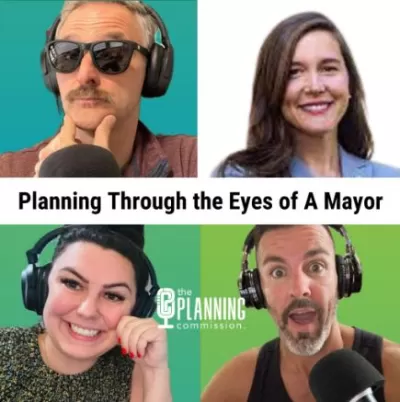Salt Lake City Mayor Erin Mendenhall joins the Planning Commission Podcast to talk about housing, street reconfiguration, and saving the largest saltwater lake in the Western Hemisphere.

If you’ve not followed what is going on in Salt Lake City, Utah, then you are missing out on what proactive leadership looks like. Erin Mendenhall, who first won election to the City Council in 2013 and ascended to the Mayor’s office after the 2019 election, is pushing housing reform, expanding the city’s green spaces, repurposing its massively-wide streets, and trying to figure out what to do with the shrinking Great Salt Lake.
“If you have not been to Salt Lake City, then you should shut this podcast off and come right now!” the 42-year old mother of three and former air quality activist told the Planning Commission Podcast.
Salt Lake City has seen the strongest post-pandemic recovery, in terms of downtown activity, of any other major city in the United States. “More people want to come here, especially after the pandemic. People want to be close to open space, trails, and five National Parks,” Mayor Mendenhall said.
These changes have led to the near doubling of downtown residential units, which could stand at nearly 10,000 people living in Salt Lake City’s core by 2025. While that growth is notably positive, it has not come without straining the local housing supply.
“We used to have housing demand coming from our kids, but now we have more in-migration along the Wasatch Front,” the Mayor said.
Salt Lake City was ready for this. Before the pandemic, the City started Thriving in Place SLC, which is a community-driven effort to analyze and understand gentrification, including the displacement that can occur as a result.
“We have 21 strategies to keep our community stable during this growth,” Mayor Mendenhall shared. “Where we cannot keep people in their current place there are strategies for helping them find new places within their community.”
The efforts haven’t stopped with housing. Salt Lake City is starting to realize the potential of its 132-foot wide streets as something other than a place to move vehicular traffic.
“One of the great things we can thank Brigham Young for is the tremendously wide streets,” said Mendenhall. “We have a Green Loop concept [to repurpose the streets] where we’ve pushed out vehicles to a single lane on both sides of the street, then added badminton, corn hole, a park, a concert stage and 190 trees in the median.”
Overall, the Green Loop plan would create 5.5 miles of repurposed streets, including 60 additional acres of parkland.
Mayor Mendenhall also discusses various other City initiatives, including water conservation efforts to help recharge the Great Salt Lake.
The Planning Commission is a spirited debate by planners, for planners. This independent outlet for all things planning explores the serious and lighter sides of the profession, poses probing and creative questions to guests, and always pairs the episode guest and topic with a choice libation. Listen to the podcast for a special offer from Planetizen.
FULL STORY: The Planning Commission Podcast, Season 2 Episode 19: Planning through the eyes of a Big City Mayor

Alabama: Trump Terminates Settlements for Black Communities Harmed By Raw Sewage
Trump deemed the landmark civil rights agreement “illegal DEI and environmental justice policy.”

Study: Maui’s Plan to Convert Vacation Rentals to Long-Term Housing Could Cause Nearly $1 Billion Economic Loss
The plan would reduce visitor accommodation by 25% resulting in 1,900 jobs lost.

Why Should We Subsidize Public Transportation?
Many public transit agencies face financial stress due to rising costs, declining fare revenue, and declining subsidies. Transit advocates must provide a strong business case for increasing public transit funding.

Paris Bike Boom Leads to Steep Drop in Air Pollution
The French city’s air quality has improved dramatically in the past 20 years, coinciding with a growth in cycling.

Why Housing Costs More to Build in California Than in Texas
Hard costs like labor and materials combined with ‘soft’ costs such as permitting make building in the San Francisco Bay Area almost three times as costly as in Texas cities.

San Diego County Sees a Rise in Urban Coyotes
San Diego County experiences a rise in urban coyotes, as sightings become prevalent throughout its urban neighbourhoods and surrounding areas.
Urban Design for Planners 1: Software Tools
This six-course series explores essential urban design concepts using open source software and equips planners with the tools they need to participate fully in the urban design process.
Planning for Universal Design
Learn the tools for implementing Universal Design in planning regulations.
Smith Gee Studio
Alamo Area Metropolitan Planning Organization
City of Santa Clarita
Institute for Housing and Urban Development Studies (IHS)
City of Grandview
Harvard GSD Executive Education
Toledo-Lucas County Plan Commissions
Salt Lake City
NYU Wagner Graduate School of Public Service




























